John Doddridge
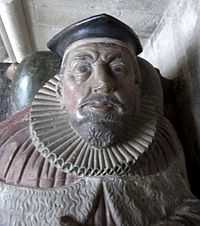
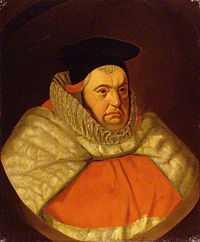
Sir John Doddridge (Doderidge or Dodderidge, etc.) (1555–1628) was an English lawyer, appointed Justice of the King's Bench in 1612 and served as Member of Parliament for Barnstaple in 1589 and for Horsham in 1604.[1] He was also an antiquarian and writer. He acquired the nickname "the sleeping judge" from his habit of shutting his eyes while listening intently to a case. As a lawyer he was influenced by humanist ideas, and was familiar with the ideas of Aristotle, and the debates of the period between his followers and the Ramists. He was a believer in both the rationality of the English common law and in its connection with custom.[2] He was one of the Worthies of Devon of the biographer John Prince (d.1723).
Origins
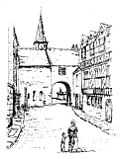
He was son of Richard Doddridge, merchant, of Barnstaple. The family took its name from a manor in the parish of Sandford, near Crediton. Richard was the son of a wool merchant and was born in South Molton, in which town he married. With his wife and eight children before 1582 he moved to Holland Street, Barnstaple and served as Mayor of Barnstaple in 1589.[3] A certain John Dodderidge, perhaps a relation, is recorded earlier in 1579 as mayor of Barnstaple.[4] In 1585 he bought a house in Cross Street from his fellow burgess Thomas Skinner, which descended in turn to his sons Sir John and to the latter's brother Pentecost Dodderidge (d. circa 1650), MP for Barnstaple in 1621, 1624 and 1625 and mayor of Barnstaple in 1611, 1627 and 1637.[5] This large timber-framed house, known as the "Dodderidge House" was demolished in about 1900 to make way for a post office, the present large sandstone building with the date "1901" sculpted on its parapet. A room of ornate carved oak panelling dated 1617 from this house survives in Barnstaple Guildhall, known as the "Dodderidge Room" and an ornate overmantel displays the date 1617 between the initials "PD" and "ED", signifying Pentecost and his wife Elizabeth.[6] The room is now used to display the Corporation's silver and the mayor's regalia. Richard entered the shipping business and owned a 100-ton prize-ship named Prudence, a privateer effectively engaged in licensed piracy. She is recorded as having had 80 men on board in 1590, and landed a record prize taken off the Guinea Coast, probably from Spanish galleons from South America, consisting of four chests of gold worth £16,000 with in addition chains of gold and civet-fur. The gold landed at Barnstaple from this voyage weighed 320 lbs. Between June and October 1590 Prudence sent back to Barnstaple two further prizes of unrecorded value and in January 1592 brought in a prize of £10,000. In March 1596 the Privy Council ordered the mayor of Barnstaple to send a ship to challenge two or three Spanish ships in the Irish Sea and the Prudence was selected for this task. She was victualled for five months, for a crew of 40, at a cost exceeding £900, borne by the North Devon population. On 8 August 1596 she returned to Barnstaple, loaded with much pillage taken during the attack on Cadiz conducted by Lords Essex and Howard.[7] Richard received at some time letters patent as one of six west country merchants licensed to trade with "the River of Senegal and Gambia in Guinea".[8] Richard presented to the Corporation of Barnstaple "a great boale with its covering, wrought in silver and a silver-gilt table lamp".[9]
Education
He was educated at Exeter College, Oxford, where he graduated BA on 16 February 1577, and entered his legal training in the Middle Temple about the same time.
Career
In 1588 he was elected Member of Parliament for Barnstaple.[10] He became an early member of the Society of Antiquaries, then recently founded. In 1602 and 1603 he delivered some lectures at New Inn on the law of advowsons. In Lent 1603 he discharged the duties of reader at his inn.
On 20 January 1604 he took the degree of serjeant-at-law, and about the same time he was appointed Serjeant to Henry Frederick, Prince of Wales. He was relieved of the status of Serjeant and appointed solicitor-general on 29 October 1604. Between 1603 and 1611 he sat in parliament as member for Horsham, Sussex. He took part in the conference in the Painted Chamber at Westminster, held 25 February 1606, on the question whether Englishmen and Scotchmen born after the accession of James I to the English throne were naturalised by that event in the other kingdom. Doddridge adopted the common-law view that no such reciprocal naturalisation took place, and the majority in the conference were with him. The question was, however, subsequently decided in the opposite sense by Lord Chancellor Ellesmere and twelve judges in the exchequer chamber (Calvin's Case). Doddridge was knighted on 5 July 1607, and created a Justice of the King's Bench on 25 November 1612. On 4 February 1614 the University of Oxford conferred on him the degree of MA. Unlike Sir Edward Coke, he showed no reluctance to give extra-judicial opinions; Francis Bacon wrote to the king with reference to Peacham's Case that Doddridge was ready to give an opinion in secret. Nevertheless he signed the letter refusing to stay proceedings at the instance of the king in the Commendam Case (27 April 1616). On being summoned to the king's presence, all the judges except Coke receded from the position they had taken in the letter; Doddridge went further to accommodate the king.
Doddridge sat on the commission appointed in October 1621 to examine the right of Archbishop George Abbot to install the newly elected bishops John Williams, John Davenant, and Valentine Cary who objected to be consecrated by him on account of his accidental homicide in a hunting accident. Directed at the time of interest in the Spanish Match (August 1623) by warrant under the great seal to soften the rigour of the statutes against recusants, Doddridge, according to Yonge, was hoped to discover a way to dispense with the statutes altogether. He concurred in the judgment delivered by Chief-Justice Nicholas Hyde on 28 November 1627 in Darnell's Case, refusing to admit to bail the five knights committed to prison for refusing to subscribe the forced loan of that year, and he was arraigned by the House of Lords in April of the following year to justify his conduct. His plea was that "the king holds of none but God".
Residences
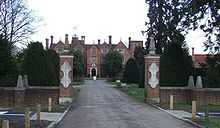
The de Dodderidge family were seated at Dodderidge in the parish of Sandford, near Crediton from the 13th century to 1746.[11] Sir John Dodderidge lived at the house inherited from his father in Cross Street, Barnstaple, and on his estate of Bremridge, 8 miles NW of South Molton, a Domesday Book manor which was later held from the feudal barony of Barnstaple.[12] (It should be noted that an ancient estate called Bremridge also exists in Sandford parish.[13]) Sir John rebuilt Bremridge in about 1622, (the date 1654 is inscribed on the entrance arch) and much of his building survived the demolition of the left wing in circa 1830.[14][15] He also acquired a lease from Sir George Speke (d.1637) (of Whitelackington, Somerset) of the estate of Heywood in the parish of Wembworthy, Devon, the most ancient English seat of that family acquired soon after the Norman Conquest of 1066.[16]
Marriages
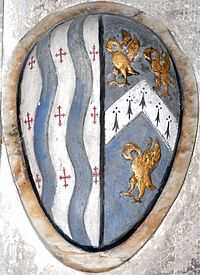
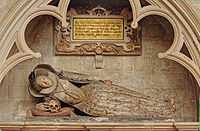
He married three times but left no issue:
- Firstly to Joan Jermyn, daughter of Michael Jermyn, twice mayor of Exeter, without issue.[17]
- Secondly to Dorothy Bampfield (d.1614), daughter of Sir Amias Bampfield (1560–1626), MP, of Poltimore and North Molton, Devon, and widow of Edward Hancock (c. 1560–1603), lord of the manor of Combe Martin, Devon, MP for Plympton Erle (1593), Barnstaple (1597) and Aldborough (1601). Above Dorothy's effigy within her monument in the Lady Chapel of Exeter Cathedral is a tablet within a strapwork surround containing the following Latin insription: "Hic jacet d(omi)na Dorothea uxor Johannis Dioderidge militis unius justiciarioru(m) d(omi)ni regis as placita coram rege tenenda assignati et filia Amisii Bampfield militis quae obiit primo Martii Anno Dom(ini) 1614" ("Here lies Dorothy the wife of John Doderidge, knight, one of the Justices of the Lord King assigned at the Pleas held before the King, and daughter of Amisus (Latinised form) Bampfield, knight, who died on the first of March in the Year of Our Lord 1614")
- Thirdly to Anne Culme, as her 2nd husband, daughter of Nicholas Culme, a younger son of Hugh II Culme (d.1545), of Molland-Champson, Devon.[18]
Death & burial
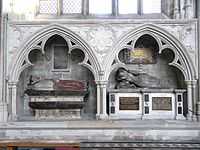
Dodderidge died on 13 September 1628, at his house Great Fosters, near Egham, and was buried in the Lady Chapel of Exeter Cathedral, with sumptuous twin monuments against the north wall containing effigies to himself and his second wife, surely the most prestigious burial site in the whole county of Devon, which Chapel contains in addition only the effigies of two Bishops of Exeter. His monument consists of his recumbent effigy sculpted in alabaster, resting on a chest-tomb, showing him dressed in scarlet robes with a court roll in his hand, all within a niche under a Gothic arch. His armorials are displayed on the wall within two cartouches as Argent, two pales wavy azure between nine crosses croslet gules, on either side of his effigy impaled with the arms of his two last wives. Next to this on the east side is an effigy of his second wife Dorothy Bampfield (d.1617), under an adjoining matching Gothic arch. The following epitaph is inscribed on a stone tablet above his effigy:
- "To the memorie of Sr John Doderidge Knight who was first sergeant at law to prince Henrie after wards solicitor general to King James of famous memorie and after that principall sergeant at law to the said King James and lastly was called by him to bee one of the judges of the honourable courte of Kings Bench wherof hee remayned a judge all the rest of his life by the space of 17 yeares. He departed this lyfe at Forsters nere Egha(m) in Surrey the XIIIth daye of September Ao Do 1628 abowte the 73th (sic) yeare of his age and according to his desire his bodie was interred heere the 14th day of October then next following."
Underneath is the following Latin cryptic chronogram:
- nVnC obIt DoDerIgVs IVDeX
- LearnIng a DIeV for DoDerIge Is gon
- to fIXe hIs earthIe to the heaVenLIe throne
If the capital Roman numerals of the first line (nunc obit Doderigus judex, "now has died Judge Dodderidge") are added up individually they make 1628, the date of his death. Likewise if the capitals in the next two lines together (the word for "earthly" has been given in the tablet as earthie, with a capital "I" in place of an "L" to make it work) are also added up they too make 1628.
These are the only lines of the chronogram surviving on the tablet in 2013, but a further two lines are quoted by Prince[19] but unfortunately without showing where the capitals lay:
- Rich urn of learned dust! scarce can be found
- More worth inshrinèd in six foot of ground
Heir
His heir was his brother Pentecost Dodderidge (died c. 1650), MP, whose own heir was his son John Dodderidge (1610–1659/66),[21] MP, whose will, dated 20 January 1658 and proved 20 June 1659 may be summarised thus:[22] John Doddridge of Bremeridge, Devon, Esq. 20 January 1658, proved 20 June 1659. If I happen to die within thirty miles of Cheshunt, Herts, my body may be carried thither and there interred in the Vault of my honoured father in law Sir Thomas Dacres of Cheshunt, knight, as near the body of my very dear virtuous and truly loving wife Martha, the youngest daughter of the said Sir Thomas Dacres, as conveniently may be, who hath promised me a burying place there according to my great desire. But if I happen to die within thirty miles of the town of Barnastaple, Devon, then I very much desire that my body may be carried to Barnstaple and buried as near the body of my dear virtuous and loving wife Jane as may be. Bequests to the town of Barnstaple, for the poor there, to the aldermen of Bristol (forty pounds) for a piece of plate with my coat of arms engraven upon it and this inscription "Ex Dono Johanni Doddridge Recordatoris Civitatis Bristoll" (i.e "From the gift of John Dodderidge Recorder of the City of Bristol"). To the poor of Ilfracombe, Fremington, and South Molton. My most dear wife Judith. My dear sisters Mistress Elizabeth Crossing, Mistress Dorothy Lowring and my nephew Master John Martin. My father in law John Gurdon Esq. and my loving brothers John Hele Esq., Thomas Dacres Esq., Robert Gurdon Esq., Master John Martin, Master Richard Crossing, Master John Lowring, Master Joseph Jackson and my friends Master Robert Aldworth, Master Edward Watts and Master Richard Sherbrook. I give and bequeath unto the College in New England towards the maintenance of scholars there the yearly sum of ten pounds forever, issuing and going forth out of my Rectory of Fremington in the County of Devon. I also give and bequeath unto the Trustees for the maintenance of select scholars at the University, according to the model drawn up by Master Poole and other godly ministers, the like yearly sum of ten pounds &c. My cousin Dorothy Watts wife of Master Edward Watts, Sarah Walker daughter of Thomas Walker minister of Assington, Suffolk. Cousin Roger Hill one of the Barons of the Exchequer. My manor of Abbotts Bury in Porbury, in the County of Somerset. My niece Jane Martin.
A monument exists in Cheshunt Church, Hertfordshire, inscribed as follows: "To the memory of Martha Doddridge, wife of John Doddridge, of Branbridge, in the county of Devon, Esq., youngest daughter of Sir Thomas Dacres, of Hertford, Knt., who died in 1655. Many daughters have done virtuously, but thou excellest them all. (Prov. xxx. 29) This is the pillar of Rachel's grave unto this day. (Gen. xxxv. 19, 80).
Works
.jpg)
Doddridge is the author of the following works published posthumously:
- The Lawyer's Light (a manual for students), London, 1629.
- History of Wales, Cornwall, and Chester (chiefly from records at the Tower), London, 1630.
- A Compleat Parson (based on his lectures on advowsons), London, 1630; 2nd ed. 1641.
- The English Lawyer (including a reprint of the Lawyer's Light and a treatise for practitioners and judges), London, 1631.
- Law of Nobility and Peerage, London, 1658.
Thomas Hearne's Curious Discourses contain two brief tracts by Doddridge: Of the Dimensions of the Land of England, and A Consideration of the Office and Duty of the Heralds in England. A Dissertation on Parliament was published as the work of Doddridge by his nephew John Dodderidge of the Middle Temple in a volume entitled Opinions of Sundry Learned Antiquaries ... Touching the Antiquity, Power, Order, State, Manner, Persons and Proceedings of the High-Court of Parliament in England (London, 1658; reprinted in 1679). It is of doubtful authenticity. The original edition of the work on deeds known as Sheppard's Touchstone of Common Assurances, and the work on the Office of Executor, assigned by Anthony Wood to Thomas Wentworth, both of which were published anonymously in 1641, have been ascribed to Doddridge. A small treatise on the royal prerogative (Harl. MS. 5220) also purports to be his work.
References
- ↑ Fuidge
- ↑ Glenn Burgess, The Politics of the Ancient Constitution (1992), pp. 23–24, 40–41, 53, 80.
- ↑ Lamplugh, p. 52
- ↑ Lamplugh, p. 156
- ↑ Lamplugh, p.156
- ↑ Lamplugh, p.134
- ↑ Lamplugh, pp.52–54
- ↑ Lamplugh, Lois, Barnstaple: Town on the Taw, Chichester, 2002, p.62
- ↑ Lamplugh, pp.53
- ↑ 'Alumni Oxonienses, 1500–1714: Disbrowe-Dyve', Alumni Oxonienses 1500–1714: Abannan-Kyte (1891), pp. 406–439. Date accessed: 19 November 2011
- ↑ Hoskins, W.G., A New Survey of England: Devon, London, 1959, p.473
- ↑ Included as Bremelrugg and Southalre (nearby South Aller) in the inquisition post mortem of William FitzMartin (d.1326), feudal baron of Barnstaple. (inq.p.m. 19 Edward II, no.710)
- ↑ Hoskins, W.G., A New Survey of England: Devon, London, 1959, p.473
- ↑ Hoskins, pp. 438–39
- ↑ http://genuki.cs.ncl.ac.uk/DEV/SouthMolton/TracyDeed.html
- ↑ Pole, Sir William (d.1635), Collections Towards a Description of the County of Devon, Sir John-William de la Pole (ed.), London, 1791
- ↑ Fuidge
- ↑ Vivian, Heralds' Visitations of Devon, 1895, p.262, Culme of Molland
- ↑ Prince, John, (d.1710), Worthies of Devon, 1810 ed. p.304
- ↑ Slightly misquoted also in Isacke's Antiquities of Exeter, p. 151, 152 and also in Fuller's Worthies
- ↑ Date of death 1666 per Dodderidge, Rev. Sidney E., Pedigree of Dudderigge alias Dodderidge, of Dotheridge, South Molton, and Barnstaple, Co. Devon, Devon & Cornwall Notes & Queries, vol. 3, no. 5, (1905) pp.166-169, p.168. However, his will dated 20 January 1658 was proved on 20 June 1659 according to the old catalogue entry of the Prerogative Court of Canterbury, "380 Pell"
- ↑ Prerogative Court of Canterbury, 380 Pell
Sources
- Dictionary of National Biography, biography of "Doddridge, John", London, Smith, Elder & Co. 1885–1900.
- Prince, John, The Worthies of Devon, 1810 edition, pp. 301–306, biography of Sir John Dodderidge
- Fuidge, N.M., biography of John Dodderidge, published in History of Parliament: House of Commons 1558–1603, ed. P.W. Hasler, 1981
- Lamplugh, Lois, Barnstaple: Town on the Taw, Chichester, 2002
Further reading
| Wikimedia Commons has media related to John Doddridge. |
- Dodderidge, Rev. Sidney E. & Shaddick, W.C., The Dodderidges of Devon, With an Account of the Bibliotheca Doddridgiana, Exeter, 1909
- Dodderidge, Rev. Sidney E., Pedigree of Dudderigge alias Dodderidge, of Dotheridge, South Molton, and Barnstaple, Co. Devon, Devon & Cornwall Notes & Queries, vol. 3, no. 5, (1905) pp.166-169
- Stebbings, Chantal, A Man of Great Knowledge: The Life of Sir John Dodderidge, 1555-1628, Exeter Law Department, Exeter University, 1989
|